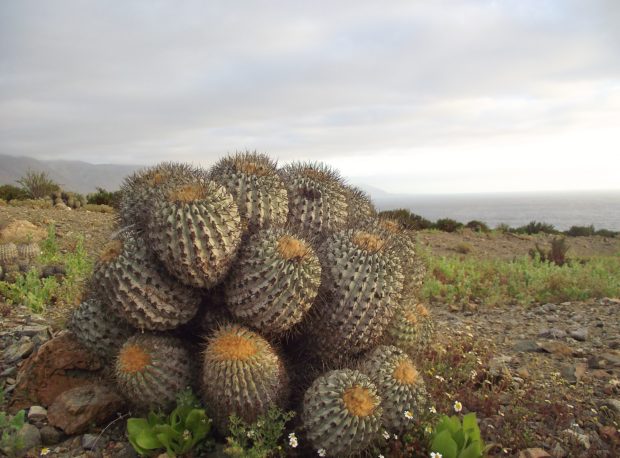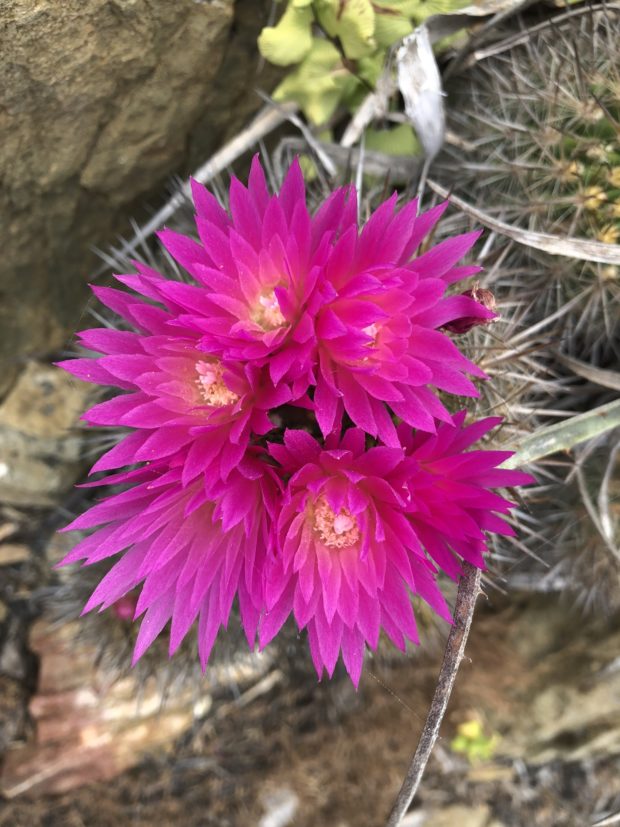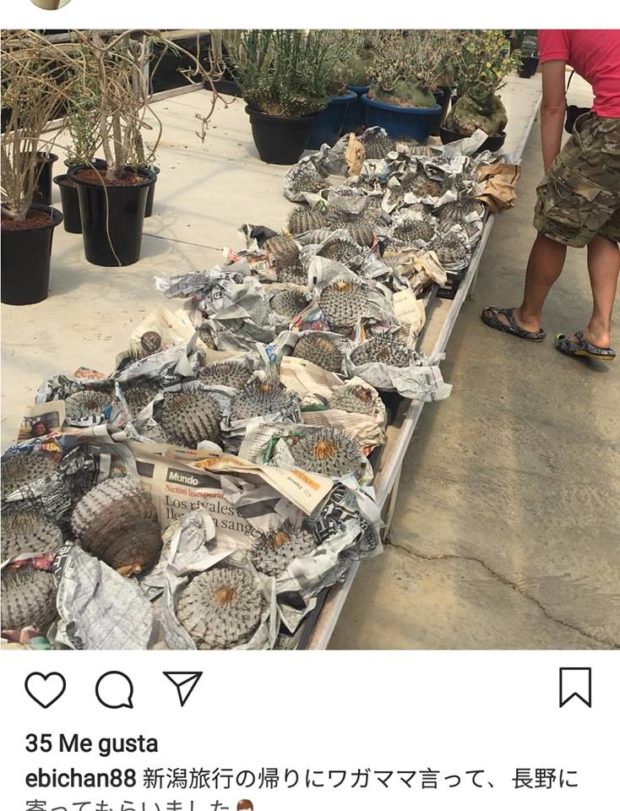
Copiapoa cinérea, endemic cacti of Antofagasta, commonly found in private collections around the world. Image: Juan Mauricio Contreras.
By Diego Almendras
Northern Chile is among the driest regions in the world, but far from being a desolate, arid wilderness, the desert overflows with life.
But people are disturbing these fragile ecosystems and the cacti that live there. Land use changes in coastal areas that they inhabit, climate change that modifies water availability and illegal trade threaten these slow-growing plants.
There are around 150 cacti species in Chile. Half are listed as vulnerable by the International Union for Conservation of Nature. A study published in Nature Plants reports that globally 31 percent of 1,480 cacti species are threatened with extinction.
In Chile, there is a hotspot of threat in the southern Atacama Desert.
Cacti are found throughout the country, even in cold areas in Aysén, near Patagonia. But they tend to live in arid zones, such as the Atacama Desert, a narrow strip of land along Chile’s northwest Pacific coast. This is a hyper arid desert where in some areas rain never has been recorded. The region’s average yearly rainfall is 0.04 inches.
These aren’t favorable conditions for plants. But in southern Atacama Desert, plants survive on the moisture gleaned from fog. With approximately 230 plant species, slow growing cactus dominate the area. The spiky plants receive moisture from marine fog, locally referred to as camachanca.
Cacti are vital for desert ecosystems as their flowers and fruits provide food for insects, which in turn are food for reptiles and birds, said Carol Peña, a doctoral student and an expert on molecular cacti ecology at Chile’s University of Concepcion.
The cacti flower yearly, providing a chance for some insects to survive during successive dry years, said Jens Wagner, a molecular plant biologist and cacti enthusiast.
But these arid ecosystems face major threats.

Chilenito (Eriosyce chilensis), is threatened by unscrupulous and unsustainable collection and is found in an extremely reduced area in coastal Chile. Image: Mario Vallejo-Marin (University of Stirling, Scotland, UK)
A new road to cross the Pan de Azúcar National Park and the coastal desert of Taltal, threatens one desert hotspot that contains nearly 14 species of cacti. Most of them, native in the Atacama region, don’t exist elsewhere.
The project that will connect Taltal with the rest of the country generates divided opinions. The road is the cheapest option, but the mayor of Chañaral, a town within the park and National Forest Corporation – a governing body of all the national parks of Chile – reject it. He and other critics claim the price is too high, causing serious damage to the park and negative consequences for its flora and fauna.
Another threat is mining, the main engine that modifies the coast of Chile, promoting the energy industry and the creation of ports.
But there is another unusual threat: cacti are a powerful attraction to collectors
Chilean cacti from coastal Atacama Desert are appreciated for their beauty, rarity and the resistance to dryness that makes them able to be stored for long times while they are traded.
Collectors are interested in less common cacti such as Copiapoa and Eriosyce, said Pablo Guerrero, a cacti expert at Chile’s University of Concepcion.
Due to their beauty and rarity, cacti are vulnerable to illegal trafficking and found only in restricted and small areas in this coastal desert. The biggest collections are found in Germany, England and Japan.
That’s awful since cacti grow very slowly, Peña said. Some specimens that are traded could be more than 150 years old.
Cacti removal can be a real force in killing specimens. Copiapoa solaris is an example of a population in very poor condition. It is extinct in Antofagasta. There are practically no living individuals, just in one house on the beach of Hornitos, where several individuals are found in a private garden, Peña said. Ironically, this species does not have a conservation status in Chilean law.
The Species Survival Network, a coalition of NGOs that prevent over-exploitation of animals and plants, says that Facebook promotes illegal traffic of endemic cacti. In Chile, for example, cactus and seeds are sold through sale groups, among birds, tarantula and reptiles. Sellers and collectors meet in Facebook groups focused in cacti. It is easy to find them under names as Copiapoa friends, Chile-Copiapoa or Eriosyce. The traders show their own living collections.
They even meet at Copiaoaton, an event where collectors from different nationalities travel the area to photograph Copiapoa species and collect seeds, Peña said. Copiapoaton has been carried out for at least 15 years, but remains as a mystery since online information is scarce and hard to find.

Screenshot of Instagram user ebichan88 shows rare cacti ready for sale.
This informal trade in seeds among Europeans could be promoted by Chileans, said Juan Mauricio Contreras, an amateur naturalist in the coastal Atacama Desert. Contreras has interviewed fishermen and local algae collectors who told him of French and Chileans who transported cacti in cargo ships to the port of Antofagasta, in northern Chile.
It is easy to see “Europeans who travel around the coastal part of the Southern Atacama Desert to collect seeds of different cactus species,” he said. There is a Facebook group that shares seeds collected in the area.
Instagram, the social networking app made for sharing photos, can also help international informal trade. It is easy to find on Instagram Japanese collectors who show off their cacti through the social media app. This can be tracked in Instagram under the hashtag #copiapoacinereavardealbata with sellers and collectors showing some cacti more than 100 years old. What drives this informal trade is the price.
A Copiapoa cinerea cactus the size of a hand can cost around $900 on Ebay. The rarest plants with variation in coloration, size and shape can go for up to $5,000 or more on the same website.
When a Japanese collector, proud of his cacti Copiapoa collection he showed on Instagram, was asked about the conservation problems that cacti face, he did not seem to care.
“As plants may be destroyed in habitat by land utilization, it is better to get them,” he said.
Once collected massively for its beautiful flowers, Chilenito (Eriosyce chilensis) is another diminished cacti. Living in north Valparaiso, this species is critically endangered in part due to its
extremely narrow natural distribution. Habitat destruction, animal foraging, coastal
desertification and fires threatens this species, Guerrero said.
There is not much information about the informal trade of Chilean cacti outside Chile. It is not illegal trade since Chile does not regulate the extraction of cactus nor its commercialization.
The only regulation existing is for international trade, Peña said. For Chile, what matters is what goes in, not what comes out.
Despite all the threats cacti face, Peña is optimistic. Chilean institutions have begun to work together with the national forest network, universities and even with private gardens to assess the current and future status of cacti, she said.
Diego Almendras is a Chilean journalist who attended a recent workshop at the Knight Center for Environmental Journalism.

It’s a very interesting article. the government and institutions should take action quickly
Pingback: La peligrosa comercialización ilegal de cactus que tiene en peligro a las especies de Atacama |
There are very few Copiapoa or Eriosyce imported into the UK. It is illegal and furthermore imported plants are banned in all UK shows.
However a glance at Facebook or Instagram will identify China and Japan as major importers. One correspondent told me 1200 plants were arriving each month in China. These are field collected by Chilean individuals. A recent importation in Japan was from Copiapoa collected in Pan de Azucar – anational park. Where were the rangers? You do remove that amount of plants in minutes.
As a regular visitor to Chile’s Atacama plants it would take me days to FIND the young plants being exported.
Chilfe needs to get its laws in order. It is far more protective about what come into the country
The case in point on Eriosyce chilensis has nothing to do with collecting. It is too common in cultivation. What has caused this demise is the summer houses built for the wealthy in Pichidangui and Los Molles.
On a recent trip to Chile I was fascinated by the cacti. I am sorry some species are being exploited so badly. I was thrilled to find and photograph what I think is a Eriosyce chilensis. I was also fascinated by all the huge summer houses in the Pichidangui and Los Molles areas. The habitat conversion in this unique and narrow band of coastal land seems to be happening at a very fast rate. Everywhere we went tracts were being subdivided and houses built. Houses built in response to housing need is one thing, but second homes on huge lots sprawling all over the countryside is wasteful and should be carefully vetted and managed. The phenomenon of second home communities can also have severe negative short- and long-term impacts on the social structure of communities.
This is not a new event. Cacti from Chile have been imported into Europe and the USA for many years. During the sixties and seventies plants were collected in large numbers by the likes of Alfred Lau (uS & Mexico) and at the height by Karel Knize. From Peru. Copiapoa are one of the I conic cactus and many collections in Europe and the US have plants from these collectors. CITIES Was introduced to protect plants from this sort of exploitation but the bureaucracy surrounding permits simply sent the this underground. China and Japan have now replaced Europe and the US as markets.
I have made over 30 trips to Chile since 1980. Much has changed and many habitats disapeared as the country enjoys new found wealth. Infrastructure in terms of roads has meant it is easy to travel throughout the Atacama and of course flights are within the reach of many people. Copiapoa will survive as the large plants are to large for the average collector but over those 30 plus years my field studies indicate regeneration is not happening at a sustainable rate. Is this due to collecting? Of course it has an impact as seen from the illustrations on the web.
Whilst this focus is on Chile it is worth reporting Mexican plants are equally suffering from illegal collecting despite Mexico’s strong laws. Again just scan the internet and you will find evidence of massive Ariocarpus and its relatives.